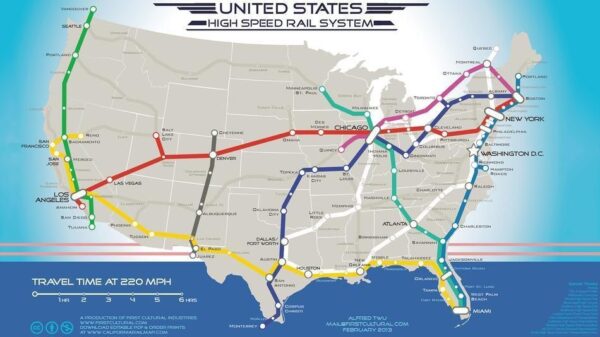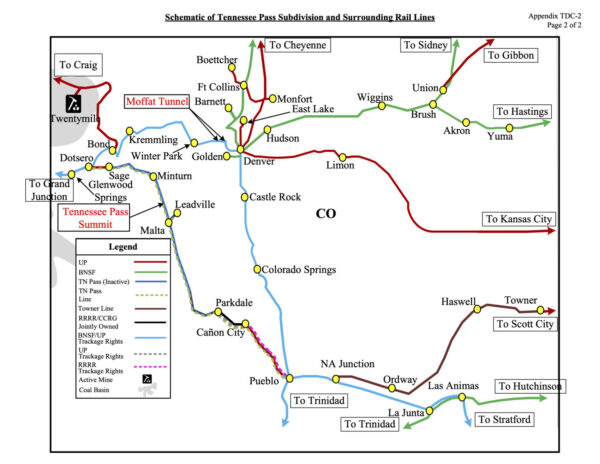Opinion: Revived rail line through Colorado ski country could bolster rivers, battle climate change

In doing some research for my appearance on Forrest Whitman’s On The Rail’s podcast on KHEN 106.9 FM radio in Salida, Colorado, I realized that I first started seriously writing about passenger rail service into the Colorado mountains back in the mid-aughts but that my true connection to trains, mountains, skiing and water runs much deeper.
I’ll dive into all of the history in a moment, but first some breaking news on the Tennessee Pass Line lease exemption filing by Colorado Midland Pacific Railroad. In a letter to the U.S. Surface Transportation Board (STB) on Monday, March 15, a Washington, D.C. attorney wrote that “erroneous” opposition to the passenger proposal based on speculation about crude oil transport had prompted an amendment request.

“In order to dispel these unwarranted concerns, CMPR respectfully requests that the Board restrict the proposed lease of the Line against the transportation of crude oil, coal and hazardous commodities,” the letter reads. “In so doing, CMPR will be authorized only to transport passengers and general commodities, except crude oil, coal and hazardous commodities over the Line. While limitations on the scope of the commodities to be handled are not usually imposed, they are not unique.”
That’s an interesting twist, especially as it relates to my previous blog post on the topic.
That prompted this lengthy response from rival Colorado Pacific Railroad, which is trying to either acquire the line or obtain a lease for transport of its grain products to the West Coast in addition to a possible passenger train from Pueblo to Minturn:
“CMPR’s filing was unusual because it asks the STB to limit the terms of its lease with UP, rather than UP and CMPR exercising their right to do so as parties to that agreement. Be that as it may, if the STB grants the request it will not eliminate the underlying issue of whether crude oil, coal or hazardous commodities traverse the line because UP is the underlying owner of the line and it cannot refuse to transport those commodities if someone makes a reasonable request for service. Colorado Pacific’s position remains that the simplified STB approval process UP and CMPR have attempted to use is not appropriate for this line, and that UP and CMPR should disclose to Colorado Pacific the restrictions on competition with other railroads that UP has inserted into the lease. This disclosure is permitted by STB rules. Colorado Pacific’s primary objective is to ensure that the Tennessee Pass be a viable alternative to UP’s Moffat Tunnel route for freight traffic, with access to both western class one carriers at each end. In satisfaction of a statutory need to ‘serve the public convenience and necessity’ Colorado Pacific has also offered to provide at its expense once daily roundtrip passenger service each way between Pueblo and Minturn, which service could be extended as far west as the Eagle Valley Airport. However, Colorado Pacific considers that there is inadequate population density to support commuter rail in the Eagle Valley, and will not be pursuing that objective. Commuter rail projects are traditionally subsidized by public funds, and the local tax base seems insufficient for such purpose. Commuter rail in the Eagle Valley is a chimera.”
Now back to my regularly scheduled blog on my personal connection to railroading in the Rockies:
First, some family history. Both my maternal grandfather, Lawrence Alone Ormsby, and my uncle, Don Hillis, worked for the Atchison Topeka and Santa Fe Railway for most of their careers, although my Uncle Don wound up with Amtrak sometime after the AT&SF merger with Burlington Northern in the 90s.
I can’t remember my first ride on a train, but it may have been in Germany in the 1970s when my father, a U.S. Air Force judge advocate general (JAG), took us on the Berlin Express Duty Train (we called it the Troop Train) from free West Germany through Soviet-occupied East Germany to Berlin. I also learned to ski around the same time at a U.S. Armed Forces Recreation ski area near Garmisch.
Since November, I’ve been writing a lot about the long-dormant, 220-mile Union Pacific Tennessee Pass Line which bisects my home for the past 30 years in Eagle County, Colorado. The battle for control of the line pits the New York developer turned agricultural powerhouse Soloviev family against Union Pacific and its proxy passenger advocate, Colorado Midland.
I don’t have a dog in this fight, but I do hope the trains come back, even though they’d be very near my house in EagleVail (and would therefore occasionally, hopefully, drown out the constant noise of the woefully inadequate and poorly maintained Interstate 70 corridor, which, like the train tracks, also follows the Eagle River and then the Colorado River after the two meet up in Dotsero). Weird, right, train tracks follow rivers, just like highways?
But I digress. After my dad was transferred from Germany back to Washington, D.C. to work at the Pentagon, I became a devotee of Washington’s Metro system, riding it frequently from our home in Arlington down to all the monuments and the Smithsonian museums on the National Mall. Back then we kept up the skiing thing on the icy slopes of western Pennsylvania.
Finally, and blissfully, my dad was transferred to Denver as one of if not the last JAGs at Lowry Air Force Base before it shut down and became a housing development. That was in the 80s, well before FasTracks light rail was approved but at a time when Wynkoop Brewery owner John Hickenlooper, later a mayor and now a U.S. senator, joined a group of rail visionaries who fought to keep Denver’s Union Station from being shut down.
After I graduated from Manual High School in Denver’s Five Points neighborhood in 1983 (site of a great light-rail line), I wound up attending Metropolitan State University in downtown Denver and working at the now-defunct Rocky Mountain News. My folks at the time moved up to Grand County and reconnected with Winter Park, where they first started skiing on weekend trips from the University of Kansas in the 50s. My dad went into private practice there and was later a county judge appointed by then Gov. Roy Romer, who used to own a different ski area.
A few times during that span I rode the Winter Park Ski Train up through 31 tunnels, including the 6.2-mile Moffat Tunnel, to the station in Fraser. I also took Amtrak’s California Zephyr from there to the Bay Area and (separately) down to Los Angeles and up to Seattle to visit relatives.
In 1991, I moved to Vail and thought nothing of the freight trains rolling through Eagle County on the Tennessee Pass Line – until they suddenly went silent in 1997 when UP merged with Southern Pacific and made the TPL inactive in order to concentrate on the Moffat line. I was sports editor at the Vail Daily, where I was first introduced to World Cup ski racing.
That would take me to Salt Lake City in 2002 to cover the Winter Olympics that landed Utah an expansion of I-15, two light-rail train lines and a massive utility upgrade, and then to Torino, Italy, in 2006, where I first experienced the joy of riding trains to ski, from Sauze d’Oulx, Italy, all the way through Milan, Bologna, over Brenner Pass to St. Anton, Austria.
My career as an Olympic journalist basically wrapped up with the 2010 Winter Games, where a friend (Tom Boyd of the Vail Valley Foundation) and I flew into Seattle and rode the rails to Vancouver and discovered that the train that used to run up to Whistler had inexplicably been shut down.

But it was those 2006 Torino Games where I really fell in love with ski trains and started actively paying attention to the possibility of maglev or some other high-speed technology being utilized along the I-70 corridor to alleviate the crush of vehicles from Colorado’s Front Range, where 80% of the state’s population lives, up into the mountains, where they all love to recreate.
The astronomical price tag for such a system, placed at $16 billion between Denver International Airport and Eagle County Regional Airport (and no doubt much higher now) has made that possibility seem like a pipe dream. But what about existing rail lines using conventional diesel locomotives (slow as hell, I know, but also a helluva lot more affordable)?
And there’s the popularity of the weekend Winter Park Ski Train, which Amtrak runs on a lease deal with the Denver-owned ski resort and the Colorado Department of Transportation contributed to with a new platform. In fact, the state is clearly quite invested in rail expansion, with its ownership of the Moffat Tunnel, which it leases to UP, and its efforts to develop Fort Collins-to-Pueblo passenger service as well as connect Amtrak’s Southwest Chief to Pueblo.
CDOT told me a few years back that Colorado’s population has increased by 50% since 1990 but its road capacity has increased just 2%, while our gas tax to pay for roads hasn’t increased at all in that timeframe. Coloradans simply do not want to pay more taxes to fund new, better roads.
Could the ski train concept for tourists and resort workers be expanded beyond Winter Park? The revival of the TPL could be a start. The TPL, while wicked steep in places, has certain other advantages over the Moffat Line – namely just five tunnels compared to 31, and billionaire Phil Anschutz, when he owned the Denver & Rio Grande Western and later merged it with Southern Pacific and then UP, paid to lower the grades in those tunnels so taller freight can move through.
Freight, whether it’s Soloviev’s grain or Uinta Basin waxy crude oil from Utah (or both), is what will pay for the estimated $278 million resuscitation of the TPL, because, unlike the federal highway system, tax dollars and national treasure are not pumped into rail lines the way they are in Europe and Asia.
And speaking of those epicenters of high-speed rail, which America’s Generation Z is apparently so enamored of, I think that’s more like what Christof Stork, who owns a seismic imaging company out of Golden, was proposing when he approached the Eagle County commissioners about an Eagle to Salida passenger rail proposal back in 2016. Or at least something faster than slow-moving diesel trains encumbered by freight traffic.
I know that’s what former Vail mayor and Salzburg, Austria, native Ludwig Kurz had in mind when I interviewed him for the Colorado Independent back in 2008. High-speed rail right up I-70. If one assumes neither of those things – faster rail, free of freight on existing tracks, or a high-speed I-70 train – will happen anytime soon, the question is whether something simpler could work to get both trucks and cars off I-70. I’ve long argued Vail and Beaver Creek don’t have a parking problem, Eagle County’s two ski areas have a car problem.
Now how does this all tie back into water, which I’ve floated via innertube, riverboard, kayak and raft from Vail to Glenwood, from Rancho Del Rio to Dotsero, from the Numbers to the Royal Gorge. Who doesn’t like to ski the snowpack all winter and float it in the spring and summer?
The argument against reviving the TPL out of the Arkansas River Valley is that trains, which are now required to have Positive Train Control technology and are therefore much safer, will derail and spill into the Ark. True, we would need to guard against that.
But if oil does start flowing from Utah toward the Gulf Coast, if the TPL is not revived, it will have to travel the Moffat Line along the Colorado River and through the Moffat Tunnel down into Denver. So you boaters along the Ark are willing to sacrifice the Upper C, where, by the way, I learned to kayak and was never bothered by the occasional train?
And, while Colorado is well on its way to decarbonizing its electric grid, the next big target needs to be transportation if we’re ever going to make a dent in mitigating against climate change. The snowpack in both the Colorado and Arkansas River valleys is being diminished every passing year by warming temperatures.
Trains, meanwhile, are up to four times more fuel efficient than trucks and will only become more efficient and less carbon-intensive as locomotives are electrified and even start running on hydrogen. There’s no bigger environmental disaster than I-70, river folks, and anything that gets cars and trucks off it while we’re trying to electrify vehicles fleets will only bolster your boating.
Finally, I want to end with a partial re-post of my 2008 Colorado Independent story in which I quoted former Vail mayor and Beaver Creek community liaison Ludwig Kurz on the beauty of European ski trains. The story also contained some choice quotes on I-70 from Avon Town Council member Tamra Nottingham Underwood, whose relatives homesteaded the area at the base of Beaver Creek, where the TPL tracks run right past the town transit center and gondola up to Beaver Creek.
First, Kurz, who connected me after the 2006 Olympics with friends and colleagues in Lech-Zurs, Austria, which is a sister city of Beaver Creek:
“It’s funny to walk along the streets in Innsbruck any day of the winter and see people with ski boots on and skis over their shoulders, and you think, ‘Where the heck are they going?’” Kurz said of the city of about 120,000 in western Austria. “It would be like walking down the 16th Street Mall and seeing someone with goggles on and fully ready to ski. In Europe you would think, ‘Of course, he’s going skiing.’
“In Europe, the upper crust of the resorts like Lech [Austria] and St. Moritz [Switzerland] draw the clientele that is used to the Mercedes and the BMW and that’s how they arrive, and some of the younger, more vibrant resorts you get more people coming by train. In Europe, a lot of the people who arrive by train are used to having a beer or two or six and they can keep their [driver’s] license that way,” Kurz said.
“The major difference between Europe and here is that that Europeans have grown up with trains and we haven’t necessarily grown up with trains here. Beyond that, it obviously works very well in Europe,” Kurz said. “If you look at what has happened in the last seven or eight years, such as the obvious congestion on I-70 — although it’s not all skier traffic — the oil prices, the cost of getting up here, the congestion and the aggravation alone that is caused by some of these long rides, we will have more and more people say there has to be a solution, and it looks like it would have to be in mass transit.”
And then, from the same 2008 article, Underwood, who still serves on Avon Town Council and is engaged in the current process. There was talk back then of never expanding I-70, which to some degree is what’s happened, in order to limit growth and to curtail traffic. Her riff-raff comment was an allusion to an infamous statement by a former Vail Chamber director.
“What’s the option to ‘bringing more growth and visitors’? Closing I-70? I didn’t know that was an option,” said Avon Town Councilwoman Tamra Underwood. “The point is, do we want the same people [who are already coming], and new, transient people — none of whom are riff-raff — continually running around the valley on obsolete, individualized, rubber-tired, fossil-fuel-guzzling, carbon-footprint-growing vehicles, or mass transit?”
Underwood’s council has pushed through a new pedestrian mall in downtown Avon, at the base of Beaver Creek ski area, that connects to a new public transit center currently served only by buses, vans and a new gondola that travels on up the mountain to the ski area. The land for the transit center was donated by the nearby Westin Hotel, and is purposefully situated along the dormant Union Pacific train tracks in the hopes that mass transit will someday run to the Eagle County Airport.
“Whatever [rail] technology is chosen in the future, and there should be quite a few options when we really look, clearly the right-of-way for that technology needs to be set aside now,” Underwood said. “The congested I-70 corridor needs a sustainable solution.”


You must be logged in to post a comment Login